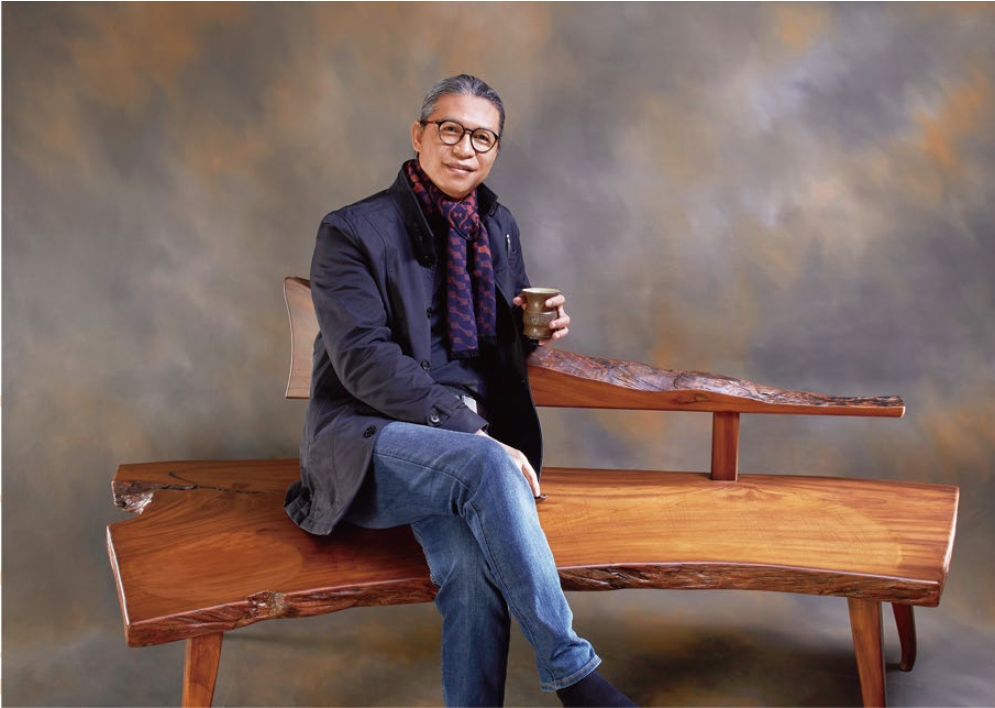The First Daxi International Wood Furniture Craftand Design Competition From the Judging Panel Convener
Tien-Li, Chen / Director, National Taiwan Craft Research and Development Institute
"The First Daxi International Wood Furniture Craftand Design Competition From the Judging Panel Convener"
In its essence, craftsmanship is about connecting humankind with nature; it’s also a representation of different lifestyle choices found around the world. In a rapidly changing society, or human experience as a whole, craftsmanship must honor its core values of respect for nature and humanity. However, traditional craft practices, now more than ever, have to modernize themselves to meet the needs of modern living, lest they should be lost forever in the tides of time. When I became director of the National Taiwan Craft Research and Development Institute in September 2023, I made “life” the central idea for the future development of Taiwan’s crafts, with these directives — “live with crafts” and “living crafts.” “Live with crafts” makes craftsmanship and craft products accessible to all, and an integral part of everyone’s lives, to encourage better cultural appreciation among the general public, thus driving up a consumer demand for quality crafts. “Living crafts” signifies a supportive environment for lifestyle-centric designs and products that meet the needs of modern consumers, therefore enabling a sustainable, positive cycle.
It’s said in Laozi’s Daodejing: “The Dao (Way) gives birth to one. One gives birth to Two, Two gives birth to Three. Three gives birth to thousands of things or all things in the universe. All things carry yin and embrace yang. Harmony is achieved for all things when yang and yin meet.” There is yin and yang in all things, and as yin and yang meet, collide, and fuse, all things move toward harmony. This Eastern philosophical viewpoint can be applied to the relationship between crafts and people, nature, and life. We can also think in terms of the three levels of need in a person’s life: the need for survival, the need for lifestyle, and the need for meaning. Crafts can meet these three levels of need through skill, art, and knowledge. We pursue the skill of craftsmanship to meet our need for survival; we perfect the art of craftsmanship to meet our need for lifestyle; and we track the knowledge of craftsmanship to meet our need for meaning. These abstract ideas are materialized in arts and crafts. Young craftsmen need just as long a time to perfect, due to the groundwork required for them to advance in skills, mettle and attitude. The goal is to develop craftsmen that can make, think, and market. As for policy areas, there needs to be a clear direction, definition, and position for crafts, as well as targets for efficacy, benefits, and efficiency. With all of these elements in place, craftsmanship could provide a better quality of life for the general public on all levels with their curated pieces. Borrowing an analogy from the natural world, crafts are like trees: an ordinary but indispensable part of everyday life. Taiwanese crafts are rooted in the fertile soil of our culture. Craftsmanship is like the tree trunks, and art and design are like the branches and leaves, making each tree unique as they stand tall. These trees form a forest—an ecosystem of crafts in which each one could thrive.
The Daxi Wood Art Ecomuseum of Taoyuan launched the Daxi International Wood Furniture Craft and Design competition to promote the continuation of Daxi’s wood crafting tradition. The first competition asked for submissions themed after “An Inspired Life with Wood Furniture,” in hopes of attracting more wood furniture aficionados to create new pieces, thus bringing better products to all users and meet their particular lifestyle preferences. The submissions are judged on three criteria: innovativeness, technicality, and practicality, which mirror the benchmarks for craftsmen who can think, make, and market. Innovativeness means designing with new materials aesthetically (thought process); technicality suggests fusing traditional with contemporary wood crafting techniques for elevated skillsets (making); and practicality denotes the consideration for commercialization and mass production potential (selling). Daxi’s wood crafts are an important part of the richness and diversity of Taiwan’s crafts, and this international competition is a platform for facilitating innovation and exchanges among talented woodworkers, driving new woodcraft development and securing Daxi’s wood arts status as a window on Taiwan for the world.
I am honored to serve as the convener of the judging panel for the first competition. The judging panel also includes Kasper Holst Pedersen, CEO of the noted Danish furniture brand PP Møbler; Professor Takamitsu Tanaka of Iwate University’s Faculty of Humanities and Social Sciences in Japan; Li-Hai Yiu, a craftsman and “the living national treasure” of Daxi wood crafting; Chien-Hui Chen, director of the Daxi Wood Art Ecomuseum; Chin-Chieh Huang, CEO of the Ruban Craft Academy in Tainan; Chi-Tsung Cheng, founder of C. T. Cheng Gallery Ltd.; Jen-Ji Chang, former director of the National Taiwan Craft Research and Development Institute; Yu-Tsung Hu, general manager of Tang-Cao Industrial Design; Chih-Feng Lin, head of the Museum Industry Research Office; and many other experts from the crafts and design community. Sixteen winning pieces were chosen from 519 submissions. Among them, the gold medal winner “WaVe” of the amateur and professional division uses solid and curved wood to create rhythmic lines that are reflected on the glass tabletop to symbolize the surface of a pool of water. In the youth division, the gold medal winner “Gradient” features a clever set of drawers that gradually increase in size, as well as subtle curves that create a soft and light visual appeal. The Special Traditional Award recipient “Wude Chair” is inspired by the Daxi Martial Arts Dojo; its streamlined design adds a touch of the minimalism trend to traditional craftsmanship.
Taiwan’s wood crafts have also broken new grounds as the world trends toward sustainability to honor the UN’s sustainable development goals (SDGs), carbon neutrality, and net zero. Taiwan is rich in forest resources, with 60% of its land heavily forested, but only 1% of the wood used in Taiwan is produced domestically. To improve the wood self-sufficiency rate, the Forestry and Nature Conservation Agency announced that 2017 would be the year of domestic wood production revival, with a goal to raise the self-sufficiency rate to 5% by 2027. Domestically produced wood presents new potential for Taiwan’s wood crafting development. In addition to technical breakthroughs and design innovations, this new policy direction also presents an opportunity for woodcrafts to acknowledge nature, the environment, and the value of life in a meaningful way.
In recent years, the National Taiwan Craft Research and Development Institute has widened its policy support by organizing programs to nurture up-and-coming craftsmen, as well as interdisciplinary training projects to work with domestically produced wood. In academia, National Taipei University of Technology (Taiwan’s first institution to teach woodworking) has been researching and developing “carbon-negative” furniture items: by using locally produced wood, the reduced carbon footprint from transportation, plus carbon captures by trees themselves, could surpass CO2 emissions from the manufacturing process. In addition, there is much R&D activity in the industry on materials, processes, and design. The future development of wood crafting in Taiwan looks bright.
Woodcraft in Daxi dates back over a hundred years, and now the Daxi Wood Art Ecomuseum is also a force for local revitalization. The Daxi International Wood Furniture Craft and Design competition is a starting point for spotlighting wood as a vital material for quality lifestyle goods characterized by the spirit of creativity, production, and entrepreneurship. Creativity means good ideas; production signifies turning these ideas into products; and entrepreneurship is underpinned by marketing these products and turning them into new businesses. We hope that there will be more diverse use of domestic wood in the future, facilitating a greener economy and strengthening sustainable consumption and production. We also hope that places around Taiwan can leverage their local specialties to launch unique and valuable brands. Taiwan’s woodcrafts have every potential to be the country’s brand centerpiece. Local perspectives are the key to global appeal, and we’re ready to showcase Taiwan’s wood crafts on the centerstage.

▶ National Taiwan Craft Research and Development Institute Official Website https://www.ntcri.gov.tw/home/zh-tw
▶ This article is included in "The First Daxi International Wood Furniture Craft and Design Competition Exhibition Journal". We warmly invite you to purchase for further reading.
▶ Copyright and Licensing Statement:
All content published on this website—including but not limited to text descriptions, images, software, audio recordings, videos, and other information—is protected under copyright law. Without prior authorization, no part or whole of the website's content may be reproduced, publicly broadcast, publicly screened, publicly performed, publicly transmitted, or adapted in any manner governed by current copyright legislation. However, actions that constitute fair use under applicable copyright law are not subject to these restrictions.

